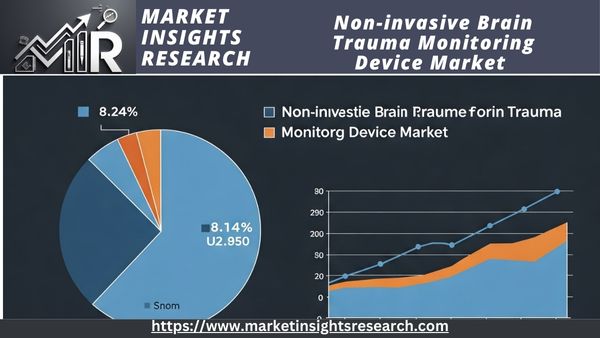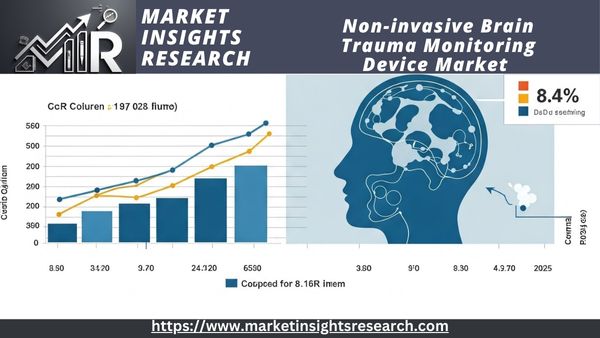Non-invasive Brain Trauma Monitoring Device Market Overview
Global Non-invasive Brain Trauma Monitoring Device Market was valued at USD 14.97 Billion in 2025 and is expected to reach USD 32.17 Billion by 2035, at a CAGR of 8.14% during the forecast period 2025 – 2035.
Non-invasive brain trauma monitoring devices are designed to assess and track brain injuries and neurological functions without requiring surgical intervention. Leveraging advanced technologies like near-infrared spectroscopy (NIRS), electroencephalography (EEG), pupillometry, and transcranial Doppler ultrasound, these devices enable the measurement of key parameters such as cerebral oxygenation, intracranial pressure, and overall brain activity.
These technologies are essential in the early detection and monitoring of traumatic brain injuries (TBIs), strokes, and neurodegenerative disorders. Hospitals, diagnostic labs, and ambulatory surgical centers are the primary end-users. The market is experiencing strong growth due to the rising incidence of brain injuries, technological breakthroughs, a shift toward minimally invasive diagnostics, and the growing adoption of wearable and portable brain monitoring tools.

Download Sample Ask for Discount Request Customization
Key Market Growth Drivers
Rising Neurological Disorders and Brain Injury Cases
The increasing number of traumatic brain injuries, sports-related concussions, and age-associated neurological conditions is fueling demand for non-invasive monitoring technologies. In the U.S. alone, TBIs account for an estimated 61,000 deaths annually. Additionally, the global burden of neurological conditions like Alzheimer’s and Parkinson’s is intensifying due to aging populations, highlighting the need for real-time and non-invasive brain monitoring solutions.
Technological Innovation in Brain Monitoring
Rapid technological advancements are transforming brain health diagnostics. Developments in portable EEG headsets, NIRS systems, and AI-enabled imaging devices are enabling healthcare providers to monitor brain activity continuously and non-invasively.
In May 2024, Canon Medical Systems introduced its AI-powered Aquilion Serve SP CT scanner in the U.S., offering streamlined brain imaging workflows and precision diagnostics—exemplifying the market’s pivot toward intelligent, automated solutions. With ongoing advancements in AI, machine learning, and digital sensors, the market is poised to witness a wave of next-gen devices that are user-friendly, efficient, and cost-effective.
Market Restraints
High Cost of Equipment Limits Accessibility
Despite their clinical value, non-invasive brain trauma monitoring devices come with high procurement and maintenance costs. Sophisticated diagnostic systems like MRI and advanced EEG devices may be unaffordable for underfunded healthcare facilities, especially in emerging markets. This disparity in access restricts their widespread adoption and contributes to inconsistent neurological care globally.
Addressing this challenge through cost-efficient device innovation, subsidies, and favorable reimbursement policies can help expand the market footprint and enable broader access to these life-saving technologies.
Emerging Market Trends
Demand Surge for Wearable Monitoring Devices
There is a growing shift toward wearable brain monitoring technologies that offer continuous real-time tracking. Lightweight, non-invasive, and easy to use, these devices are being widely adopted for at-home care, telehealth, and long-term neurological condition management. Patients with epilepsy, TBIs, and chronic migraines benefit from constant supervision, reducing the risk of severe episodes and improving outcomes.
Boost in Neurological R&D and Investment
Global investments in brain health research and non-invasive diagnostics are surging. Governments and private players are funding the development of smarter, AI-powered tools that offer predictive analytics, early diagnosis, and customized interventions. Initiatives like the U.S. BRAIN Initiative are fueling innovation, supporting the emergence of more sophisticated, scalable brain monitoring technologies.
Download Sample Ask for Discount Request Customization
Key Market Opportunities
Expansion in Emerging Healthcare Markets
The market is witnessing strong growth potential in emerging economies due to rising healthcare investment and better infrastructure. Countries across Asia-Pacific, Latin America, and parts of Africa are increasing their healthcare budgets and welcoming new technologies to enhance neurological care.
Asia-Pacific, in particular, is anticipated to grow at a CAGR of over 10%, driven by government initiatives, population health needs, and greater adoption of diagnostic technologies. Companies entering these regions with localized, cost-efficient solutions can tap into massive, underserved patient populations.
AI Integration and Predictive Brain Monitoring
Integrating artificial intelligence and machine learning into brain monitoring devices is reshaping diagnostic precision. AI tools can rapidly analyze EEG signals, identify anomalies, and provide real-time decision support to clinicians. These technologies are also enabling remote diagnostics and proactive treatment plans, making brain trauma care more timely, efficient, and personalized.
Report Scope
|
Parameter
|
Details
|
|
Report Title
|
Global Non-invasive Brain Trauma Monitoring Device Market Forecast 2025–2035
|
|
Forecast Period
|
2025 to 2035
|
|
Base Year
|
2024
|
|
Market Size (2024)
|
USD 14.98 Billion
|
|
Market Size (2035)
|
USD 32.19 Billion
|
|
CAGR (2025–2035)
|
8.13%
|
|
Segments Covered
|
Product Type, Application, End-User, Region
|
|
Product Types
|
Monitoring Devices, Consumables
|
|
Applications
|
Traumatic Brain Injury, Stroke, Neurodegenerative Disorders, Epilepsy
|
|
End-Users
|
Hospitals, Ambulatory Surgical Centers, Diagnostic Centers, Research Institutes
|
|
Regions Covered
|
North America, Europe, Asia-Pacific, Latin America, Middle East & Africa
|
|
Key Players
|
Luciole Medical, Canon Medical Systems, Philips Healthcare, Medtronic, GE HealthCare
|
|
Key Trends
|
AI Integration, Wearable EEG Devices, Growth in Telehealth
|

Download Sample Ask for Discount Request Customization
Market Segmentation Analysis
By Product Type
-
Monitoring DevicesThe largest segment, including EEG systems, ICP monitors, NIRS units, and transcranial Doppler devices. These systems are the backbone of non-invasive neurological diagnostics.
-
ConsumablesIncludes disposable sensors, probes, and electrodes. While essential, they represent a smaller share due to lower unit costs and single-use nature.
Key Players
-
Luciole Medical AG
-
Canon Medical Systems
-
Philips Healthcare
-
GE HealthCare
-
Medtronic plc
-
Nihon Kohden Corporation
-
Masimo Corporation
-
NeuroSky Inc.
-
BioSignal Group
-
Spiegelberg GmbH & Co. KG
Regional Outlook
North America dominates the market, driven by high prevalence of TBIs, established healthcare infrastructure, and substantial funding in neurological research. With over 2.8 million TBIs reported annually in the U.S., and neurodegenerative diseases like Alzheimer’s affecting over 6 million Americans, the region continues to lead in both demand and innovation.
Strong support from institutions like the CDC, NIH, and BRAIN Initiative ensures continuous development and adoption of advanced, non-invasive brain monitoring technologies.
Recent Developments
-
June 2023Luciole Medical AG acquired Spiegelberg GmbH & Co. KG, combining portfolios to become a leader in next-generation EEG and brain monitoring solutions.
-
May 2024Canon Medical Systems installed the first AI-powered Aquilion Serve SP CT scanner at SDMI in Las Vegas, setting a new benchmark in imaging precision and workflow efficiency for neurological diagnostics.
Market Segmentation
By Product Type
-
Monitoring Devices (EEG, ICP Monitors, NIRS Systems, Transcranial Doppler)
-
Consumables (Sensors, Electrodes, Disposable Probes)
By Application
-
Traumatic Brain Injury (TBI)
-
Stroke Monitoring
-
Neurodegenerative Disease Diagnosis
-
Epilepsy and Seizure Monitoring
By End-User
By Region
-
North America
-
Europe
-
Asia-Pacific
-
Latin America
Middle East & Africa


